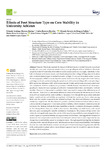Effects of Foot Structure Type on Core Stability in University Athletes

Use este enlace para citar
http://hdl.handle.net/2183/34661Colecciones
- Investigación (FEP) [507]
Metadatos
Mostrar el registro completo del ítemTítulo
Effects of Foot Structure Type on Core Stability in University AthletesAutor(es)
Fecha
2023-06-30Cita bibliográfica
Moreno-Barriga, O.S.; Romero-Morales, C.; Becerro-de- Bengoa-Vallejo, R.; Losa-Iglesias, M.E.; Gómez-Salgado, J.; Caballero- López, J.; Vidal-Valverde, L.C.; López-López, D. Effects of Foot Structure Type on Core Stability in University Athletes. Life 2023, 13, 1487. https://doi.org/10.3390/ life13071487
Resumen
[Abstract] Purpose: This study assessed the impact of different types of medial foot arch on postural
stability and core center of gravity muscle activity among collegiate athletes. Methods: The study
sample included 103 university-level athletes across various sports (soccer, rugby, basketball, volleyball,
field tennis, table tennis, karate, and cheerleading) from the College of Magdalena (Colombia)
who exhibited distinct types of medial foot arch: 32 high, 35 low, and 36 neutral arches. Surface
electromyography (sEMG) was employed to assess conduction velocity, magnitude values, latency,
and fatigue in focal muscles including the spinal erector (SE), internal oblique (IO), external oblique
(EO), and rectus abdominis (AR), while measurements of static and dynamic postural control were
also considered. Post hoc analysis was performed with Bonferroni correction for all electromyographically
measured muscle groups, as well as for measurements of static and dynamic postural
stability. Pearson’s or Spearman’s correlation tests were used to compare the different types of
feet. Results: There were no substantial differences observed between the distinct types of feet in
terms of focal muscle activity, static stability, or dynamics. Even though the mean values indicated
higher muscle activity and stability among those with high foot arches and lower values among
those with low arches compared to the neutral foot type, this observed difference was deemed
statistically insignificant. We also observed a positive correlation between internal oblique muscle
activity and the average power of dynamic postural stability, which remained consistent across all
foot types. Our findings indicate that static instability is directly correlated with dynamic instability
in the anteroposterior direction, while a clear inverse relationship was established in the lateral
direction upon examining the variable correlations. Conclusions: The presence of high or low foot
arches did not significantly impact the activity of the muscles responsible for maintaining the body’s
center of gravity or postural stability among university-level athletes. This suggests the existence of
neuromuscular compensation mechanisms that attempt to restore balance and compensate for any
changes in postural stability caused by varying foot types. Through targeted training that emphasizes
activation of the internal oblique muscle, athletes may see improved postural stability. Our findings
indicate that static stabilization exercises can also prove beneficial in improving dynamic stability
in the anteroposterior plane, while a more dynamic approach may be required to improve dynamic
stability in the lateral plane.
Palabras clave
Foot
Public health
Stability
Pie
Salud pública
Estabilidad
Public health
Stability
Pie
Salud pública
Estabilidad
Versión del editor
Derechos
Atribución 3.0 España






